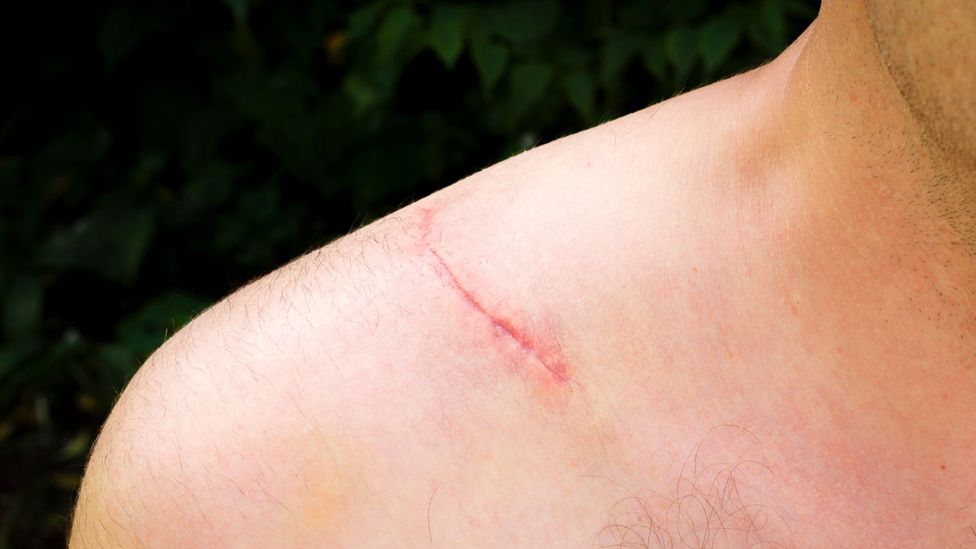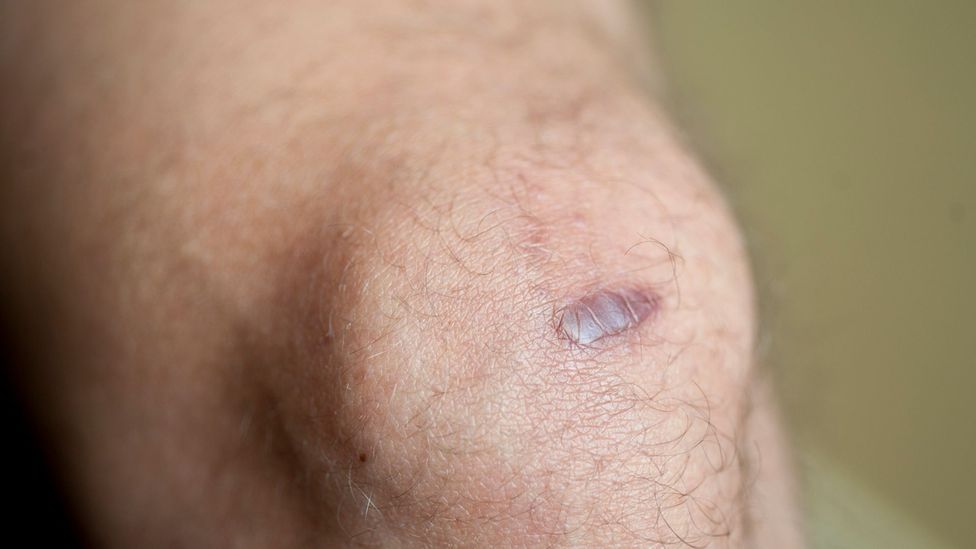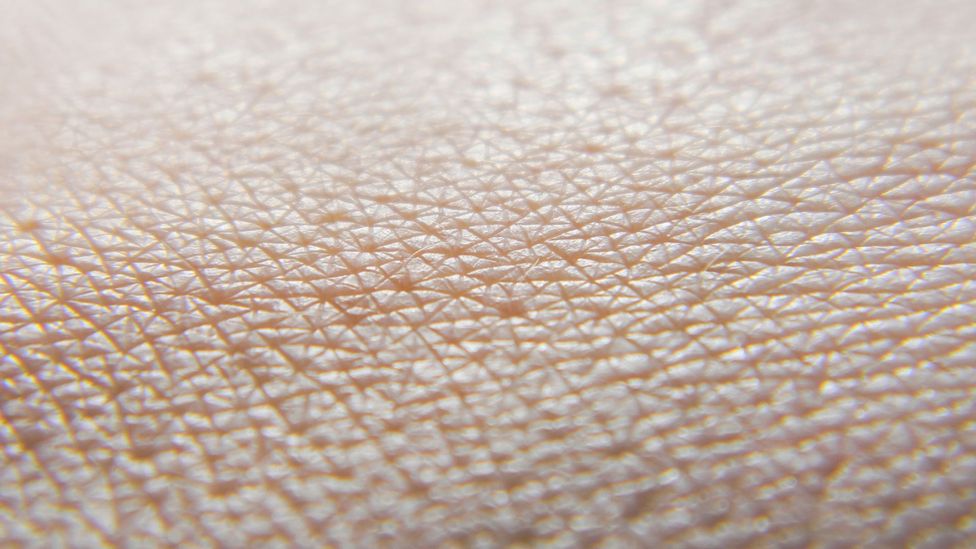How Does Tpe Skin Feel
Why is scar tissue different to normal skin?

A scar tells the world of injuries by – but why does scar tissue look and feel and so different? BBC Time to come investigates.
W
When I was ten or 11 years old, I hurt my knee at summer camp when I barbarous running around a gravel-covered walkway with some of my bunkmates. I fell hard enough that a few tiny pieces of gravel actually embedded themselves nether the skin that covered my kneecap.
In the hospital, after the nurses wiped abroad the blood and washed the gravel bits out of the skin, they placed a bucket under my leg and poured rubbing booze over it. It hurt, but at least I didn't become an infection. What I did go, however, was a nice scar. Then in that location was the time I stabbed my hand with a pocketknife while attempting to open boxes in my higher dorm room. Despite my best efforts, that, too, resulted in a scar on my left hand, in the space betwixt my thumb and first finger.
Nearly anybody has a good scar story (or two, or three) they can tell in an endeavor to 1-upwards their friends' stories. But what exactly is scar tissue anyway?

Scabs protect the wound from infection - and then grade scars (Credit: iStock)
For one thing, a scar is a virtual certainty post-obit a wound of any sort, at least to some degree. That's because a scar is the natural outcome of the body'south normal healing process every bit it works to repair the skin or another of its organs. However, animals that regenerate parts of their bodies, similar limbs or tails, can practise this without scarring.
Later on a wound, burn, or injury, the beginning thing the torso does is bleed. The second matter the body does is course a blood jell. The very top layers of the clot dry and harden to form a scab, which protects the wound from additional disturbances. Protected from the external world, the lower portion of the clot becomes host to cells called fibroblasts, whose job in part is to replace the scab with scar tissue.
But while the tissue that makes up a scar is made of the same stuff as normal skin – a protein called collagen, primarily – it looks and feels different. In a 1998 paper in the Message of Mathematical Biological science, University of Warwick mathematicians John C Dallon and Jonathan A Sherratt explained why. "In humans and other tight-skinned animals," they wrote, "collagen has a cross-weave construction in normal tissue, whereas in scar tissue it is aligned parallel to the plane of the skin."
In other words, normal skin tissue is synthetic of fibres that are oriented randomly to each other, while the very same fibres, in scar tissue, are oriented in a unmarried direction, parallel to each other.
It'due south actually quite reasonable, from an evolutionary perspective. An open wound leaves the torso susceptible to all sorts of problems, from intense hurting to infection. And so rather than slowly build skin the usual way, scars are the piece of work of the body's rapid response team.

The brand-upwards of normal skin is very different to that found in scar tissue (Credit: iStock)
Call up of it this style – if yous've got a hole in your roof and it's raining, it's not worth waiting for the best carpenter in town if the second-best carpenter is available. Especially if he tin can become the job done in half the time for one-half the toll. Information technology's better to protect the body from the outside world as presently equally possible, even if the handiwork is a bit sloppy.
While some scars are a source of pride, others might be aesthetically displeasing. And though there aren't any methods to completely avert scarring, there are ways to minimise their germination or appearance. For one thing, larger wounds hateful larger scars. That's why doctors so often employ stitches. Reducing the corporeality of space between the two ends of a wound results in a smaller scab, and therefore a smaller scar.
If a scar is particularly unsightly, a dermatologist might recommend "revising" the scar. In this procedure, the scar is entirely removed and the skin is re-stitched. Because scars are unavoidable, a new one volition form, only the doctor can work to arrive less obvious.
Other forms of treatment, similar chemical peels or dermabrasion work by removing the outermost layers of peel. The skin then heals from this kind of controlled attack, and as a upshot the newer, younger pare could appear more than uniform.
But while each of these methods may result in an improved appearance for some folks nether some conditions, none of them actually remove scars entirely. They only alter them, adjust them, relocate them, or otherwise increase their acceptability.
Just a skin graft can completely remove a scar, and even and so a new scar will appear forth the edges of the graft. So until medical scientific discipline comes upwardly with something better, the bulk of us will only have to remain content with trading scar stories.
Join 700,000+ Future fans past liking u.s. on Facebook , or follow usa on Twitter , Google+ , LinkedIn and Instagram
If you liked this story, sign up for the weekly bbc.com features newsletter , called "If Yous Only Read vi Things This Week ". A handpicked pick of stories from BBC Hereafter, Earth, Culture, Capital, Travel and Autos, delivered to your inbox every Friday.
Source: https://www.bbc.com/future/article/20161007-why-is-scar-tissue-different-to-normal-skin
Posted by: lambertabirloyst1974.blogspot.com


0 Response to "How Does Tpe Skin Feel"
Post a Comment